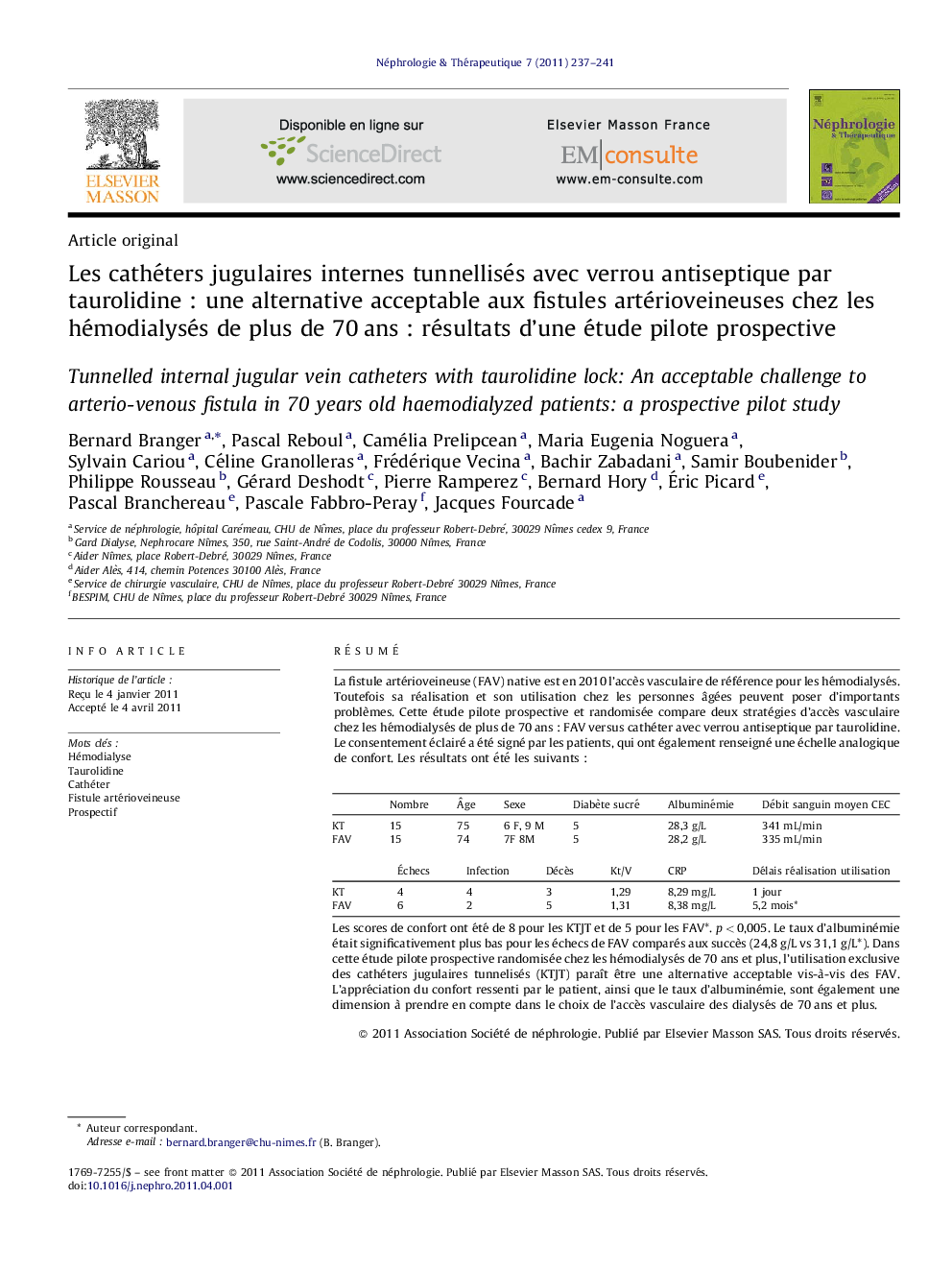| کد مقاله | کد نشریه | سال انتشار | مقاله انگلیسی | نسخه تمام متن |
|---|---|---|---|---|
| 3894958 | 1250136 | 2011 | 5 صفحه PDF | دانلود رایگان |

RésuméLa fistule artérioveineuse (FAV) native est en 2010 l’accès vasculaire de référence pour les hémodialysés. Toutefois sa réalisation et son utilisation chez les personnes âgées peuvent poser d’importants problèmes. Cette étude pilote prospective et randomisée compare deux stratégies d’accès vasculaire chez les hémodialysés de plus de 70 ans : FAV versus cathéter avec verrou antiseptique par taurolidine. Le consentement éclairé a été signé par les patients, qui ont également renseigné une échelle analogique de confort. Les résultats ont été les suivants :NombreÂgeSexeDiabète sucréAlbuminémieDébit sanguin moyen CECKT15756 F, 9 M528,3 g/L341 mL/minFAV15747F 8M528,2 g/L335 mL/minÉchecsInfectionDécèsKt/VCRPDélais réalisation utilisationKT4431,298,29 mg/L1 jourFAV6251,318,38 mg/L5,2 mois*Full-size tableTable optionsView in workspaceDownload as CSVLes scores de confort ont été de 8 pour les KTJT et de 5 pour les FAV*. p < 0,005. Le taux d’albuminémie était significativement plus bas pour les échecs de FAV comparés aux succès (24,8 g/L vs 31,1 g/L*). Dans cette étude pilote prospective randomisée chez les hémodialysés de 70 ans et plus, l’utilisation exclusive des cathéters jugulaires tunnelisés (KTJT) paraît être une alternative acceptable vis-à-vis des FAV. L’appréciation du confort ressenti par le patient, ainsi que le taux d’albuminémie, sont également une dimension à prendre en compte dans le choix de l’accès vasculaire des dialysés de 70 ans et plus.
Arteriovenous fistula (AVF) is still in 2010 the gold standard of vascular2 access in haemodialysis (HD) patients. Nevertheless it may be difficult to obtain and/or to use AVF in elderly. With this prospective randomised pilot study, we compare two strategies of vascular access in 70 years old or more new HD patients. AVF were compared to tunnelled jugular vein catheters (TIJC) with taurolidine as bacterial lock solution. Results were as follow:NumberAgeGenderDiabetes mellitusAlbuminemiaBlood flowKT15756 F, 9 M528.3 g/L341 mL/minFAV15747 F, 8 M528.2 g/L335 mL/minFailureDeathInfectionThrombosisHospitalisationKT/VCRPUse delayKT434251.298.29 mg/L1 dFAV652671.318.38 mg/L5.2 m*Full-size tableTable optionsView in workspaceDownload as CSVThe responses with the visual analogic scale of comfort was 8/10 for TIJC and 5/10 with AVF * P < 0.05. In five TIJC patients, heparin was added with success to taurolidine because of partial clotting of catheters. Albuminemia was significantly lower in AVF failure patients compared to AVF success patients (24.8 g/L vs 31.1 g/L). This pilot study allows to conclude that TIJC is an acceptable challenge to AVF in haemodialysed patients of 70 years or more in a two years long use.
Journal: Néphrologie & Thérapeutique - Volume 7, Issue 4, July 2011, Pages 237–241